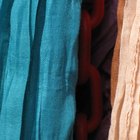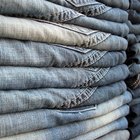
Robert Pitman/Hemera/Getty Images
Wool is the traditional mainstay fabric for making suits, because this nubby textile is warm, versatile, strong and attractive. In more recent times, however, polyester has gained popularity as a wool alternative. Today, many suits are made from fabrics that blend wool and polyester together, hoping to get the best qualities of both the natural and synthetic products.
Price Comparisons
Wool fabrics include tweed, flannel and worsted. In comparison to man-made polyester, wool is definitely the more expensive textile . When shopping for a wool garment, the suit's final price depends on the quality of wool used and how many “twists” the fabric has -- which is itself a correlation to the fineness of the strands. Standard wool garments have 60 to 80 twists, while 100 and up are considered premium, and can become some of the most expensive fabrics available. Polyester is the synthetic, inexpensive alternative.
Feel the Fabric
Nothing beats the softness and breathability of real wool. On the other hand, it can be itchy, and may get heavy and bulky. Tweed suits, for instance, are not generally flattering on heavy-set men for that very reason. Some lighter wool fabrics are made from tropical wools, but they wrinkle easily. Polyester is wrinkle-free and smooth to the touch, but it’s stiff and doesn’t breathe, which can result in you becoming hot and sweaty.
Durability and Style
Perhaps surprisingly, the natural fibers of wool endure longer than the synthetic ones of polyester. A good wool suit may last you for a long time, even with heavy use, while polyester suits begin to acquire shiny spots where the fabric encounters the most friction, such as your elbows. In wool and polyester blend suits, the polyester fibers often rub against the wood fibers, causing them to fray. In a mark against it, wool is subject to shrinkage and discoloration if not cleaned properly, while polyester retains its shape much better.
Warmth and Breathability
Wool is both warm in winter and, because of its breathability, cooler in summer than polyester. Of course, that depends on the particular woolen fabric used. Flannel, for instance, is an excellent winter fabric, but far too heavy for summer wear. Polyester is a light fabric and will not keep you very warm in the winter, but because it doesn’t breathe, you could end up sweating more than you would in a woolen suit.
Appearance
While a pleasing appearance is ultimately in the eye of the beholder, most people would say that polyester, at least on its own, looks cheap. Wool drapes better and has a superior texture and quality to it. The multitude of wool fabrics, with their varying thicknesses, textures and sheens, will always hold more appeal for the fashion conscious.
Related Articles

Natural Vs. Synthetic Clothing

Linen vs. Wool Blazer

The Advantages of Polyester Cotton

Polyester Vs. Silk Dresses

How to Preserve Moleskin

The Advantages of Wool Clothing

How to Stop Wool From Itching

Description and Characteristics of ...

Types of Wool Sweaters

How to Wash an Acrylic & Viscose Scarf

Types of Linen Fabric

The Properties of Suede Finished ...

Nylon vs. Cotton Panties

Properties of Cotton Fabric

Twill vs a Cotton-Polyester Blend

Differences Between Polyester and Nylon ...

Fake Vs. Real Pashmina

What Are Twill Pants?

The Difference Between Polartec and ...

What Is Fleece Fabric Made From?
References
Photo Credits
Robert Pitman/Hemera/Getty Images